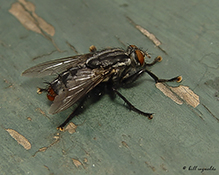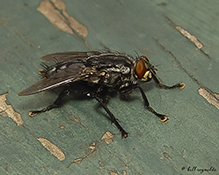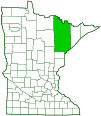Red-tailed flesh fly
(Sarcophaga africa)
Conservation • Description • Habitat • Ecology • Distribution • Taxonomy
Conservation Status |
|||
| IUCN Red List | not listed |
||
| NatureServe | not listed |
||
| Minnesota | not listed |
||
Description
Flesh flies are often the first or one of the first insects to visit a corpse. This makes them useful in determining the amount of time that has elapsed since a person has died. Red-tailed flesh fly is a small to medium-sized flesh fly.
Red-tailed flesh fly probably originated in Africa. It is believed to have spread widely due to the activities of humans. It is now cosmopolitan, occurring worldwide, wherever there are human populations.
Adults are 5 ⁄16″ to 9 ⁄16″ (8 to 14 mm) long. They resemble the house fly but are slightly larger. The female is slightly larger than the male.
The large compound eyes are dark red and face forward. There is a large bristle (arista) on the third segment of the antenna. The arista is long and is feathery only at the base. The mouthparts are designed for lapping liquid.
The thorax is ashy gray with three blackish longitudinal stripes. It is not metallic. There are 4 bristles on the notopleuron (a region on the thorax), and a row of bristles on each side of the thorax just above the base of the hind leg. The abdomen is gray with black markings in a checkered pattern. On the male the external genitalia at the end of the abdomen are reddish-brown.
The legs are black.
The wings are clear and have brown veins. The lobes at the base of the wing (calypter) is well developed. The R5 cell is narrowed or closed at the end (distally).
Size
Total length: 5 ⁄16″ to 9 ⁄16″ (8 to 14 mm)
Similar Species
Habitat
Anywhere human or animal dung or carrion is found
Ecology
Season
Summer
Behavior
Adults begin copulating 2 to 9 days after emerging. The female carries the eggs in her body 9 to 13 days or more. The eggs hatch while still inside her body. She then deposits the 40 to 80 first instar larvae in carrion or dung. The larvae complete three instars, usually in 3 or 4 days, before pupating. In colder temperatures it may take up to 9 days. The pupal stage lasts about 16 days. Development from first instar to adult usually takes about 23 days but is greatly affected by temperature.
Life Cycle
Larva Food/Hosts
Carrion or dung.
Adult Food
Human and animal dung.
Distribution |
||
|
Sources |
|
| 10/8/2025 | ||
Occurrence |
||
Common and widespread |
||
Taxonomy
Order
Suborder
Brachycera
Infraorder
Cyclorrhapha
Zoosection
Schizophora
Zoosubsection
Calyptratae (calyptrate flies)
Superfamily
Oestroidea (bot flies, blow flies, and allies)
Family
Sarcophagidae (flesh flies and satellite flies)
Subfamily
Sarcophaginae (typical flesh flies)
Genus
Sarcophaga (common flesh flies)
Subgenus
Bercaea
Taxonomic Uncertainty
Until recently, red-tailed flesh fly was known by the scientific name Sarcophaga haemorrhoidalis. That name is widely used in forensic entomology literature. The status of this fly is now in flux. Several scientific names are in current use.
NCBI – Sarcophaga haemorrhoidalis
ITIS – Bercaea cruentata
Systema Dipterorum – Ravinia pernix
GBIF – Sarcophaga africa, Ravinia pernix, Bercaea cruentata
iNaturalist – Sarcophaga africa, Ravinia pernix
BugGuide has no listing for any of these names, or any scientific name for the red-tailed flesh fly.
Some sources treat Sarcophaga africa and Sarcophaga/Ravinia pernix as separate species, some as the same species.
Subordinate Taxa
Synonyms
Bercaea cruentata
Bercaea haemorrhoidalis
Gesneriodes disjuncta
Musca striata
Musca haemorrhoidalis
Myophora hemisphaerica
Myophora limpidipennis
Myophora horticola
Myophora campestris
Pierretia parva
Ravinia hebes
Ravinia pernix
Ravinia sulcata
Ravinia ctenodasypygiina
Sarcophaga africa
Sarcophaga aozia
Sarcophaga azoa
Sarcophaga haematodes
Sarcophaga haemisphaerica
Sarcophaga haemorrhoidalis
Sarcophaga pernix
Common Names
red-tailed flesh fly
Glossary
Arista
A large bristle on the upper side of the third segment of the antenna of a fly. Plural: aristae.
Calypter
Either of two membranous lobes that cover the haltere at the base of the forewing of a fly.
Visitor Photos
Share your photo of this insect.
This button not working for you?
Simply email us at info@MinnesotaSeasons.com.
Attach one or more photos and, if you like, a caption.
Bill Reynolds |
||
 |
 |
|
MinnesotaSeasons.com Photos
|

Slideshows

Visitor Videos
Share your video of this insect.
This button not working for you?
Simply email us at info@MinnesotaSeasons.com.
Attach a video, a YouTube link, or a cloud storage link.
Other Videos



